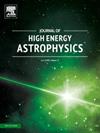FSRQ B2 1348+30B多波长分析:对射流功率的制约
IF 10.5
4区 物理与天体物理
Q1 ASTRONOMY & ASTROPHYSICS
引用次数: 0
摘要
我们利用Swift-UVOT、Swift-XRT和Fermi-LAT观测,对平谱射电类星体B2 1348+30B进行了为期14.5年的多波长分析。在γ射线波段,3天的bin光曲线显示了在2010年9月19日(55458 MJD)和2022年5月26日(59725 MJD)在通量水平(2.5±0.5)×10−7ph cm−2s−1和(5.2±0.6)×10−7ph cm−2s−1检测到的两个主要耀斑事件。对耀斑的贝叶斯块分析表明,变异时间尺度≤3天。为了研究光源的动态特性,获得了三种通量状态的多波长光谱,其中包括两个耀斑状态和一个相对较低的状态。在所有状态下,源的γ射线能谱都可以用具有最大光子能量<的幂律模型很好地拟合;20 GeV。在x射线中,幂律模型可以解释耀斑态光谱,而低通量态则需要具有极硬高能量分量的破幂律模型。这表明在康普顿谱成分中存在低能量截止。一个包含同步加速器、同步加速器自康普顿机制和外康普顿机制的简单单区轻子模型可以成功地再现所有通量态的宽带光谱能量分布。模型参数表明,在高通量状态下,射流洛伦兹因子显著增加。利用最佳拟合参数约束低通量态硬高能谱中发射电子分布的最小能量。这一分析得到了扩展,得出了耀变体射流动能的极限,并与中心黑洞的爱丁顿光度进行了比较。本文章由计算机程序翻译,如有差异,请以英文原文为准。
Multi-wavelength analysis of FSRQ B2 1348+30B: Constraints on the jet power
We present 14.5-year multi-wavelength analysis of flat-spectrum radio quasar B2 1348+30B using Swift-UVOT, Swift-XRT, and Fermi-LAT observations. In the γ-ray band, the 3 day bin lightcurve reveals two major flaring events on 2010-09-19 (55458 MJD) and 2022-05-26 (59725 MJD) detected at flux levels and . The Bayesian block analysis of the flares suggested the variability timescale to be ≤ 3 day. To study the dynamic nature of the source, multi-wavelength spectrum was obtained for three flux states which includes the two flaring state and a relative low state. The γ-ray spectra of the source in all the states are well fitted by a power-law model with maximum photon energy < 20 GeV. In X-ray, a power-law model can explain the flaring state spectra while a broken power-law with extremely hard high energy component was required to model the low flux state. This indicates the presence of the low energy cutoff in the Compton spectral component. A simple one-zone leptonic model involving synchrotron, synchrotron self Compton and external Compton mechanism can successfully reproduce the broad-band spectral energy distribution of all the flux states. The model parameters suggest significant increase in the jet Lorentz factor during the high flux states. Further, the best fit parameters are used to constrain the minimum energy of the emitting electron distribution from the hard high energy spectrum of the low flux state. This analysis was extended to draw limits on the kinetic power of the blazar jet and was compared with the Eddington luminosity of the central black hole.
求助全文
通过发布文献求助,成功后即可免费获取论文全文。
去求助
来源期刊

Journal of High Energy Astrophysics
Earth and Planetary Sciences-Space and Planetary Science
CiteScore
9.70
自引率
5.30%
发文量
38
审稿时长
65 days
期刊介绍:
The journal welcomes manuscripts on theoretical models, simulations, and observations of highly energetic astrophysical objects both in our Galaxy and beyond. Among those, black holes at all scales, neutron stars, pulsars and their nebula, binaries, novae and supernovae, their remnants, active galaxies, and clusters are just a few examples. The journal will consider research across the whole electromagnetic spectrum, as well as research using various messengers, such as gravitational waves or neutrinos. Effects of high-energy phenomena on cosmology and star-formation, results from dedicated surveys expanding the knowledge of extreme environments, and astrophysical implications of dark matter are also welcomed topics.
 求助内容:
求助内容: 应助结果提醒方式:
应助结果提醒方式:


